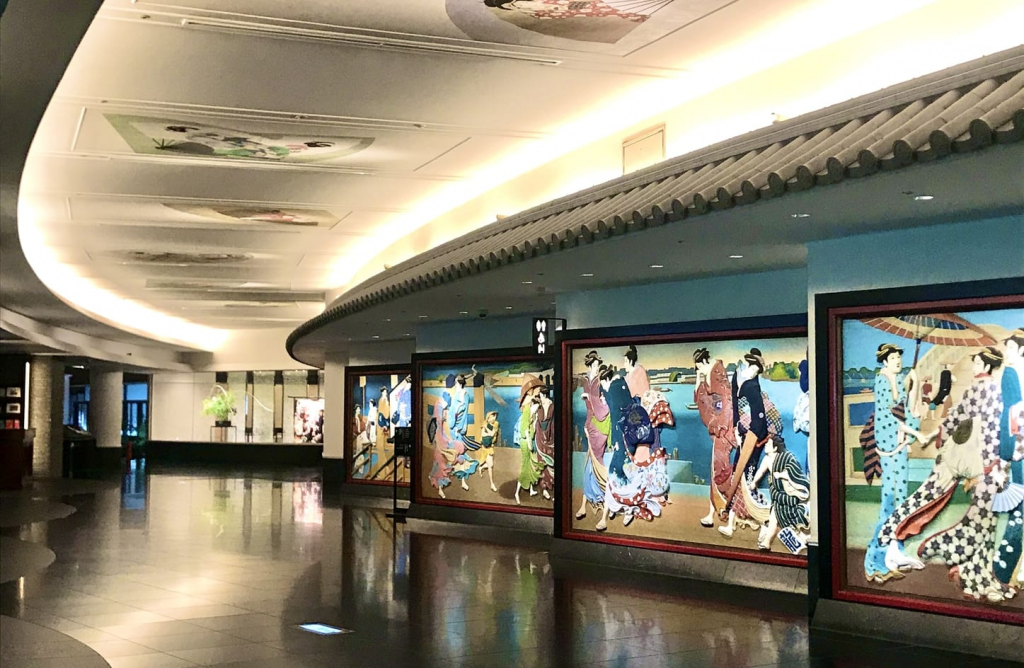Museum entrance fees in Tokyo can be quite pricey, but you can equally enjoy eclectic flavors of art for free inside some of Tokyo’s luxury hotels. Hotel Gajoen Tokyo in Meguro, The Okura Tokyo in Kamiyacho, Palace Hotel Tokyo in Marunouchi and the Grand Hyatt Tokyo in Roppongi are four of the best Tokyo hotels worth visiting solely for their art and design offerings.
1. Hotel Gajoen Tokyo
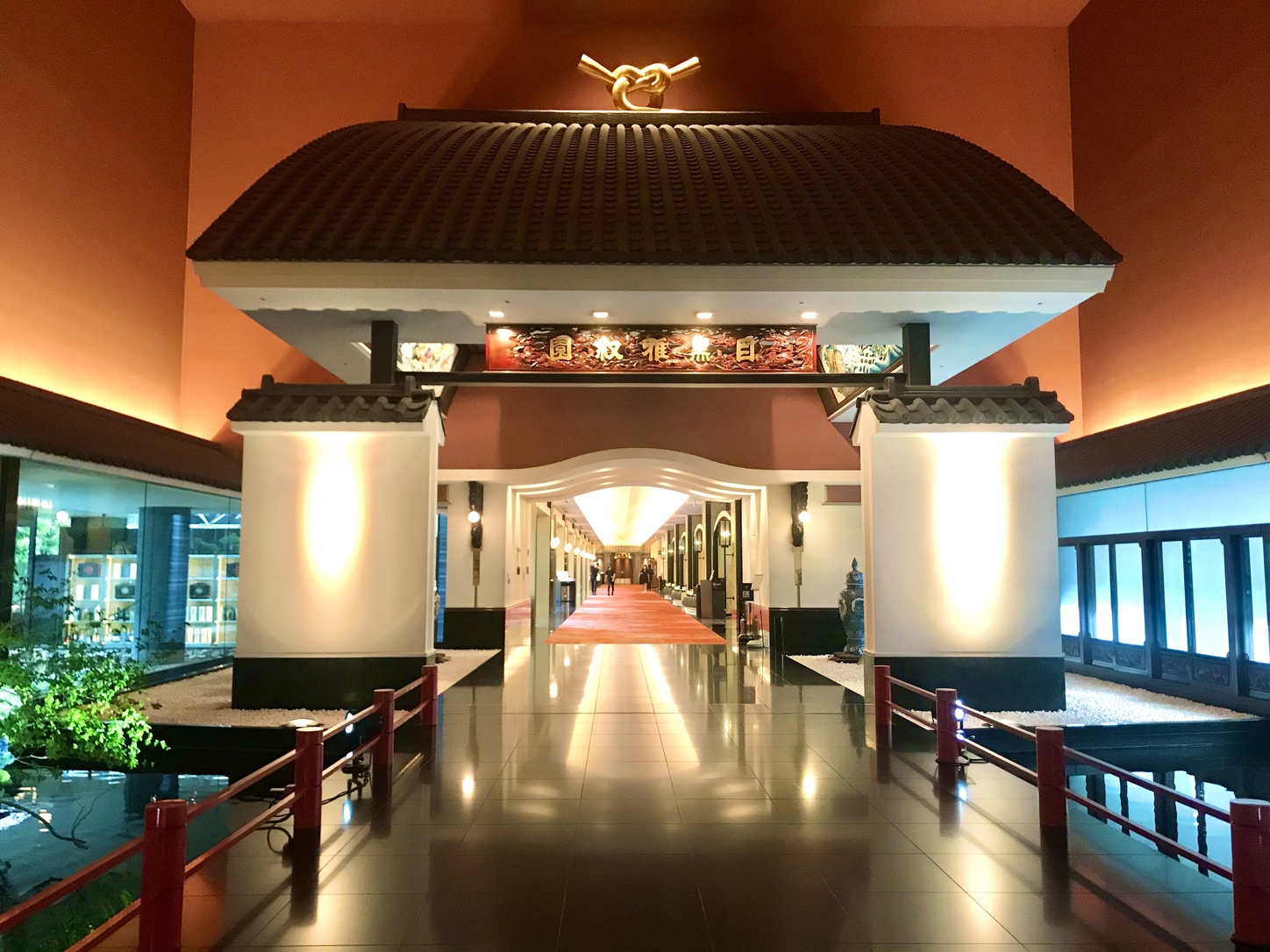
Gajoen Daimon
One of the most well-preserved establishments in Japan’s capital, Hotel Gajoen Tokyo dates back to 1931. The hotel originated as the Shibaura Gajoen Japanese and Chinese restaurant in the late 1920s. Rikizo Hosokawa, Gajoen’s founder, eventually expanded the restaurant with opulently decorated rooms and a bridal salon and studio, turning it into a luxurious wedding complex. The hotel pays homage to traditional Japanese art, as well as the Art Nouveau movement of the early 20th century. It all results in an opulent aesthetic.
Gajoen’s entrance leads to a long corridor of huge, colorful wood-carved panels depicting Edo life. The left side of the pathway is lined with red Japanese-styled guard rails, a pond and wood-carved panels on the wall by artists Chikuha Otake and Horei Sakari. They depict twenty-one Japanese scenic sights. On the right side are traditional Mikoshi (portable shrines) and an antique ceramic jar. The ceilings reveal charming paintings of women in kimonos, ornamental fans and flora.
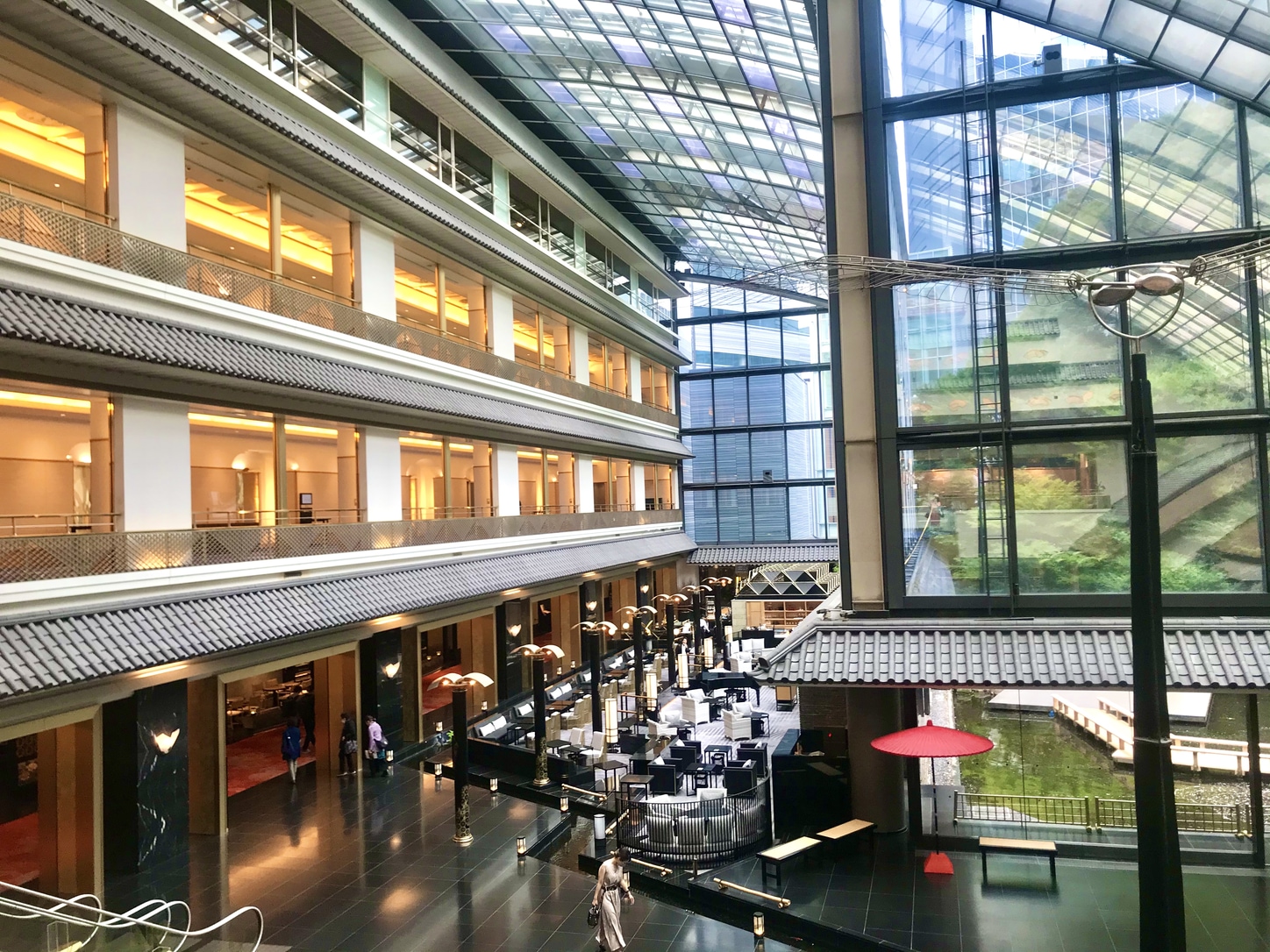
Pandora Café
Finally, you can view the captivating “Welcome Gate” or Daimon, with a ridge-decorated copper roof designed by Kyu Suzuki. The gate is adorned with lacquer glass fittings and colored wood carvings of a dragon and a tiger. This corridor leads to the spacious and modern Pandora Café lounge, surrounded by Japanese-tiled overhangs for every floor. Pretty fan silhouettes also shine on the interior balconies.
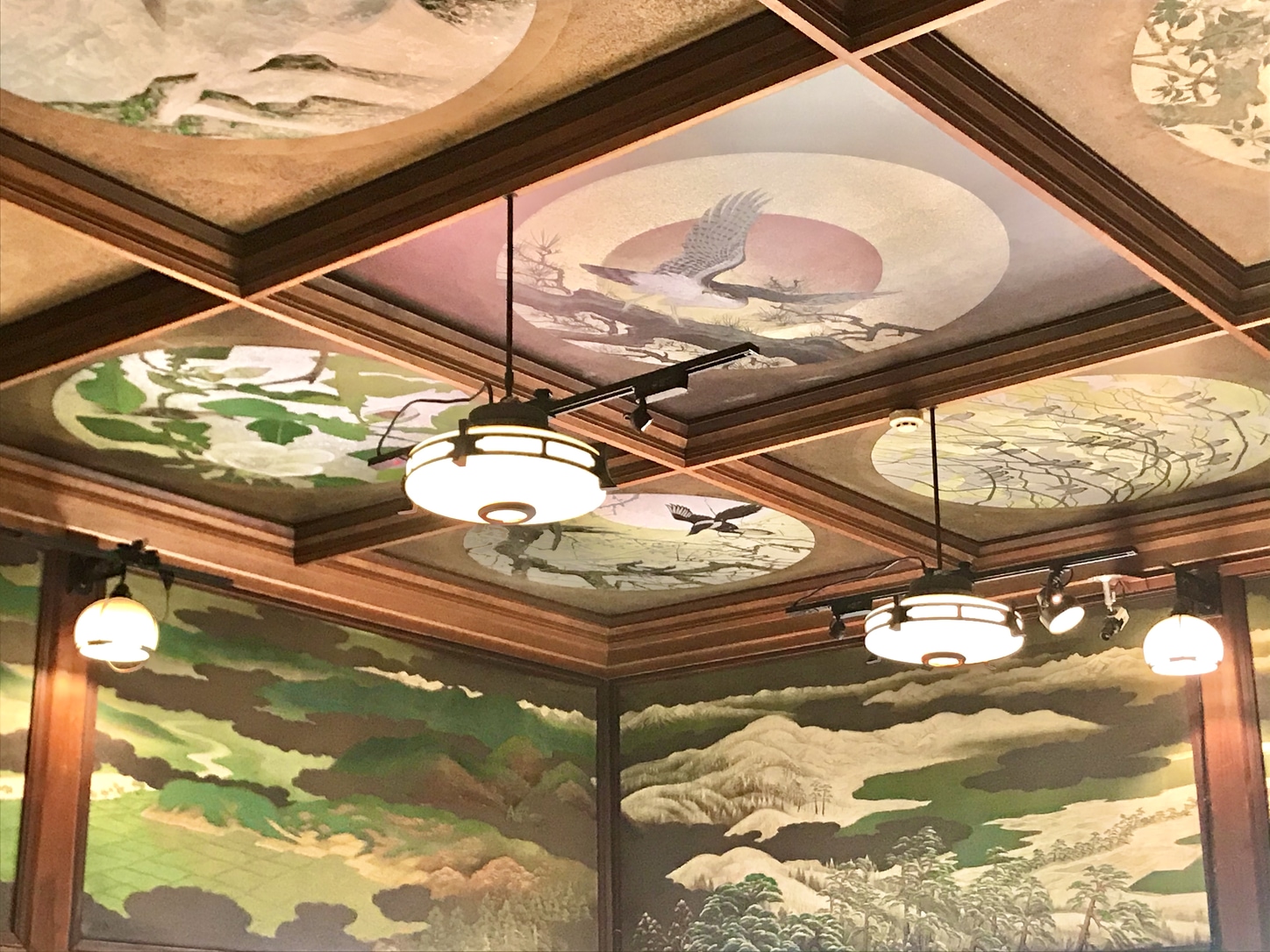
Hyakudan Kaidan, Soukyu Room ceiling
Not to be missed are the lobby restrooms with a traditional red bridge, red doors and wall and ceiling murals. Art flows everywhere and never gets tiring. The hotel is also popular for the Hyakudan Kaidan (100-steps staircase), a designated Tangible Cultural Property of Japan. The fully decorated seven rooms illustrate vivid ancient paintings on fusuma doors, walls and ceilings. They also include traditional Kumiko latticework in the sukiya-style architecture. This “Museum Hotel of Japan Beauty” boasts nearly 2,500 artworks, including 700 Japanese paintings.
2. The Okura Tokyo
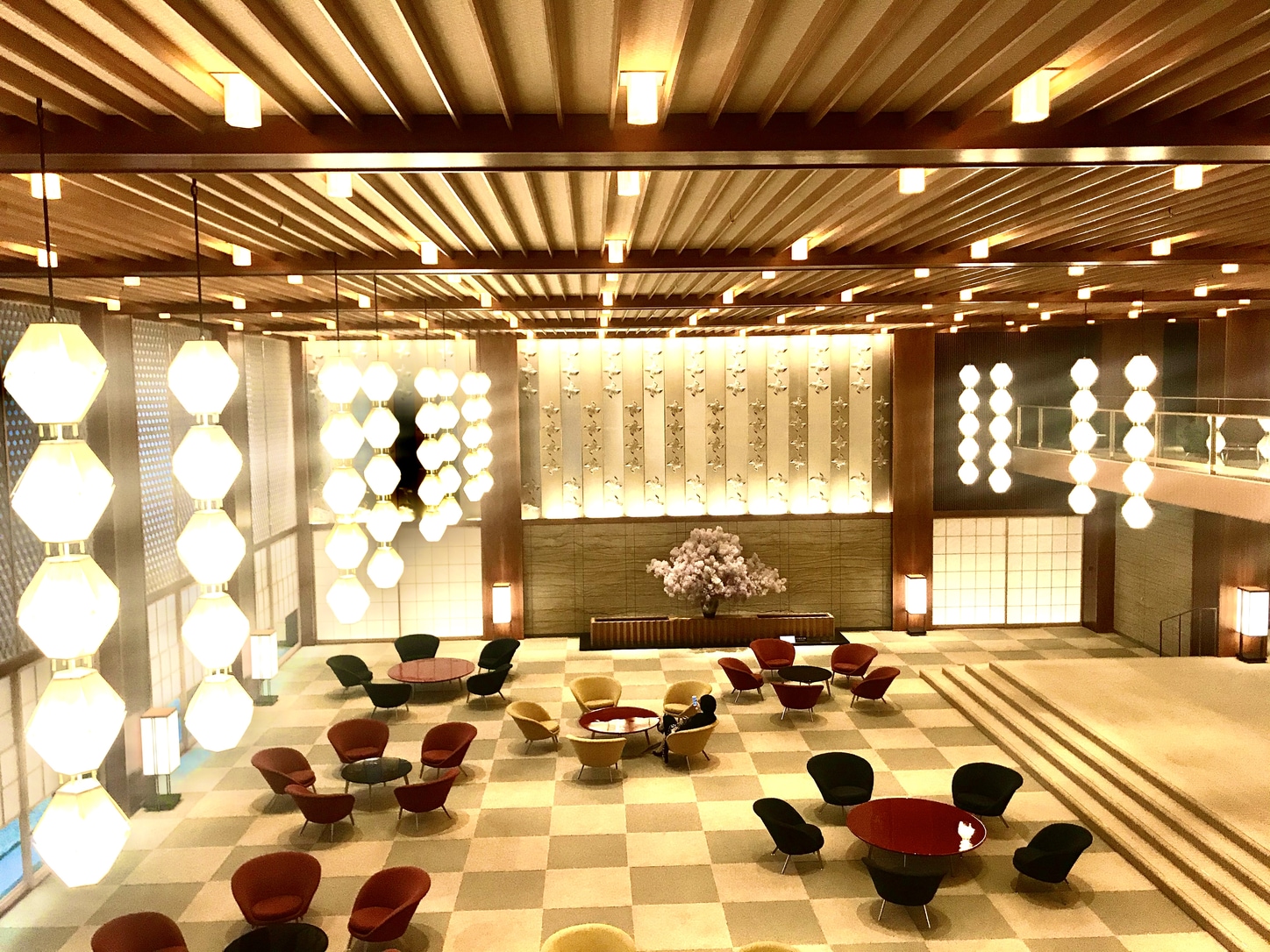
Okura Prestige lobby
Since its establishment in 1962 and the much-publicized rebirth in 2019, Hotel Okura Tokyo continues to reaffirm its reputation as one of Tokyo’s most important architectural and historical icons. The hotel boasts two glass buildings: The Okura Heritage wing and the Okura Prestige Tower. The new lobby of the latter has been impeccably redesigned by Yoshio Taniguchi, son of renowned architect Yoshiro Taniguchi. It was his father who designed the elegant original and Yoshio has maintained his legacy with the new lobby.
Inside the lobby, the famous Okura lanterns hang like royal jewels. These have been partly recreated into pentagon-shaped frameworks in a kirikodama style derived from necklace motifs from the Kofun period. The soft natural light bounces off the grid-patterned walls and Kumiko hemp-leaf patterns from the Asuka period. One wall is detailed with the restoration of the original hotel’s beautiful three-dimensional four-petal flower motifs designed by ceramic artist and former Living National Treasure Kenkichi Tomimoto. They complement the deep black and vermillion lacquered tables resembling the center of plum flowers. The reupholstered red, yellow, black and blue modern chairs represent the petals.
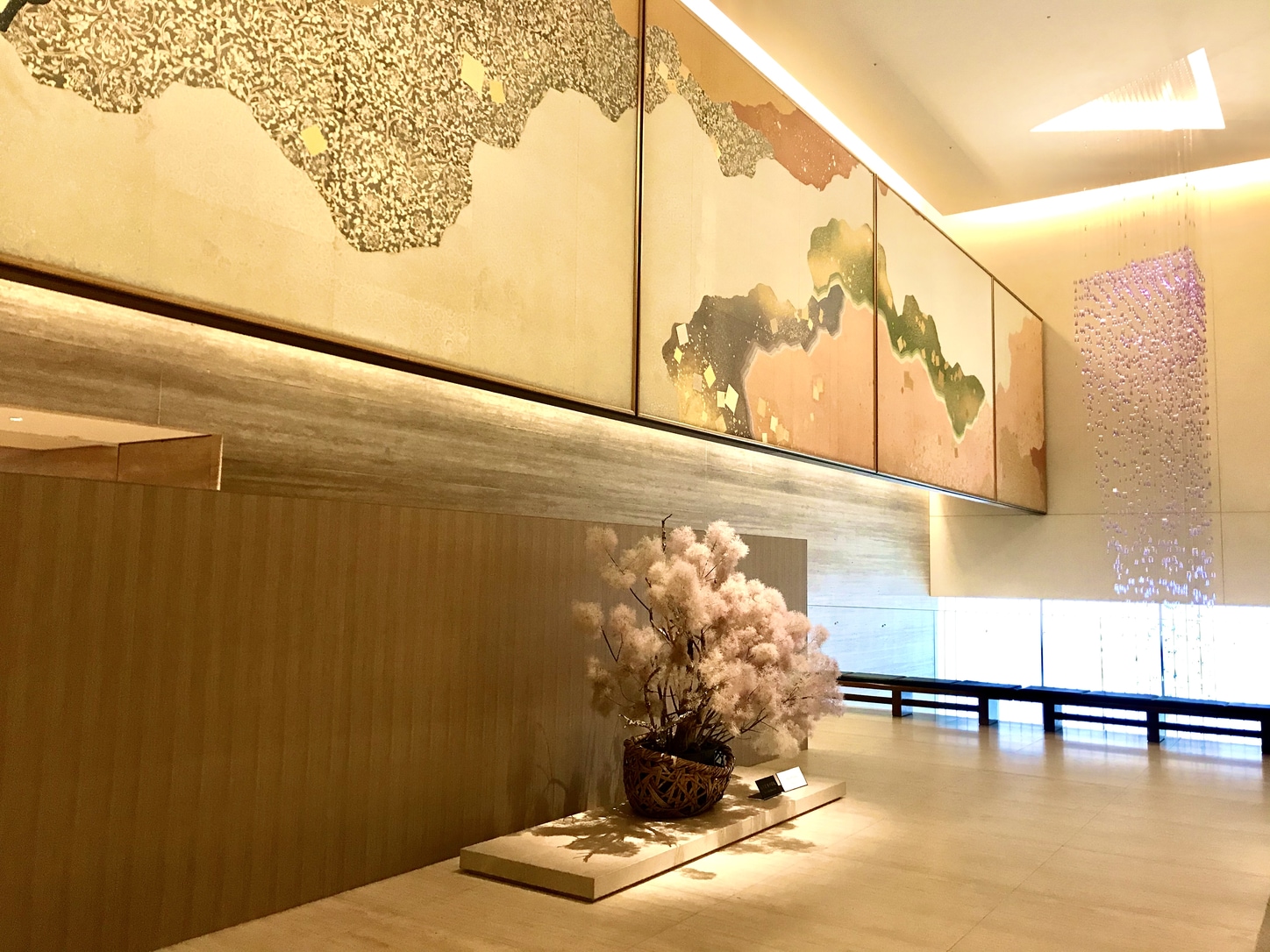
Okura Heritage lobby
The simple Okura Heritage lobby, also redesigned by Yoshio Taniguchi, exudes tranquil grace through the Japanese paper mural on the front wall patterned after “The Thirty-Six Immortals of Poetry” scroll collection from the Heian Period. Exquisite purple wisteria-motif chandeliers further emphasize Japanese aesthetics.
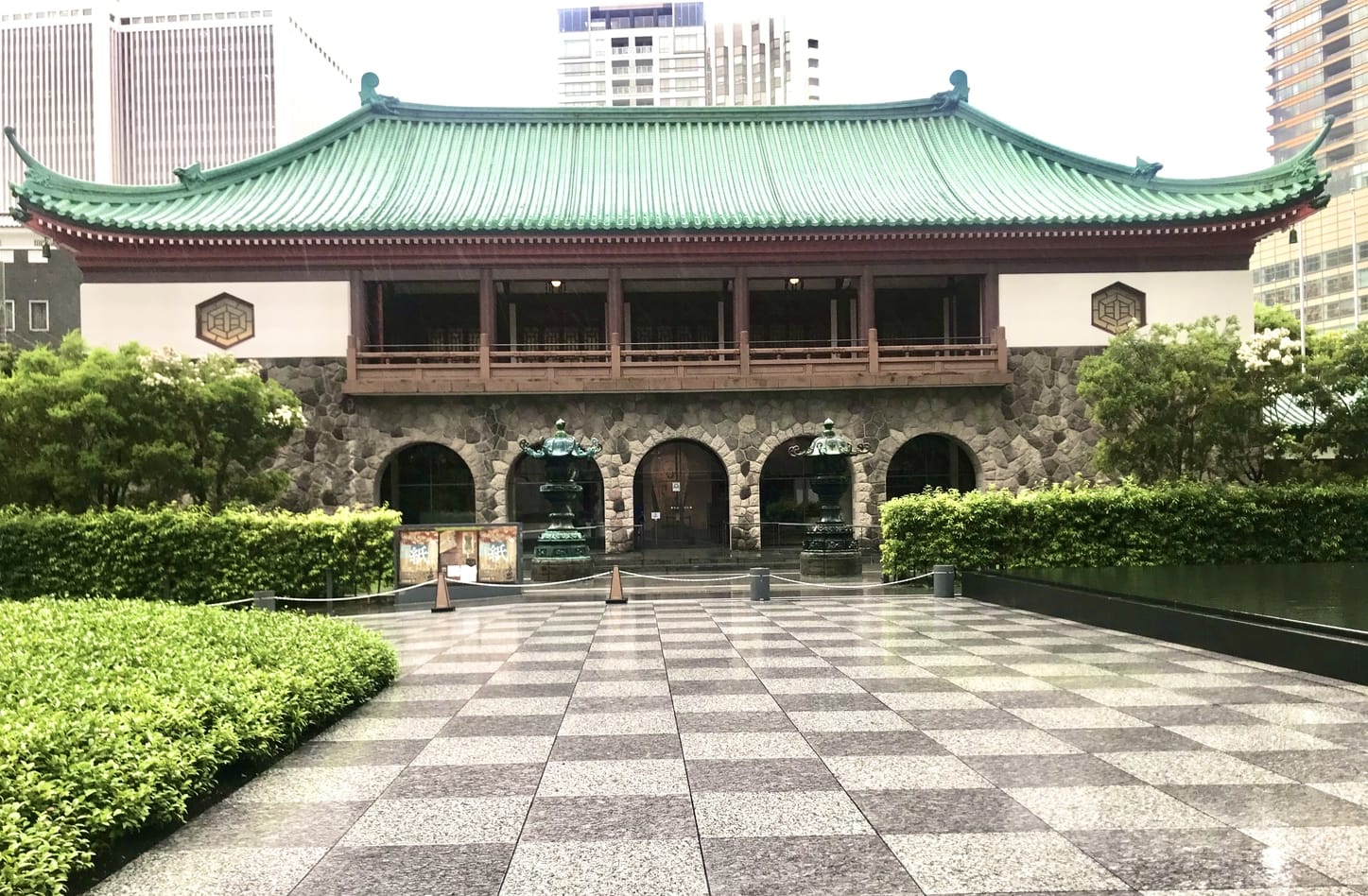
Okura Museum of Art
Visitors can also check out ongoing exhibitions at the Okura Museum of Art (Okura Shukokan) which was established in 1917 by industrialist and builder of the Okura conglomerate Kihachiro Okura. The museum consists of about 2,500 works from the Okura family’s Japanese and East Asian antique collections, including National Treasures and Important Cultural Properties.
3. Palace Hotel Tokyo
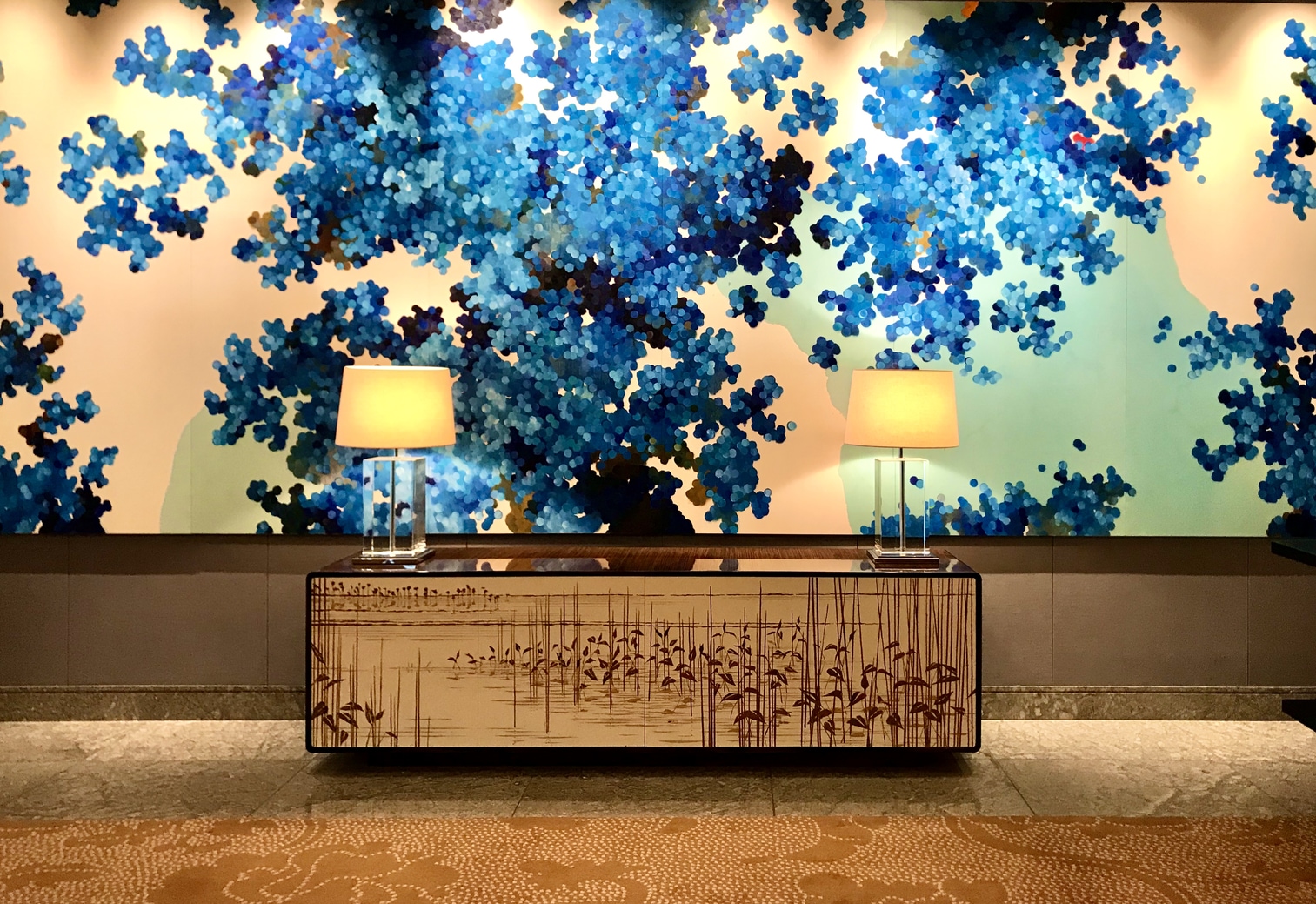
“Shikisai no Shita” by Satoshi Uchiumi
Another historical landmark, which originally stood as the Forestry Office of the Imperial Household before opening as a hotel in 1961, is the Palace Hotel Tokyo in Marunouchi. The building’s grand renewal in 2012 carefully retained the traditional Shigaraki tiles on the outer walls and the old ink wash painting at the entrance of the Chiyoda Suite. More than 720 artworks based on the concept of “The Palace Garden — Inheritance and Innovation” can be enjoyed, ranging from traditional ink and contemporary oil paintings, sketches, rock sculptures and laser-cut paper art.
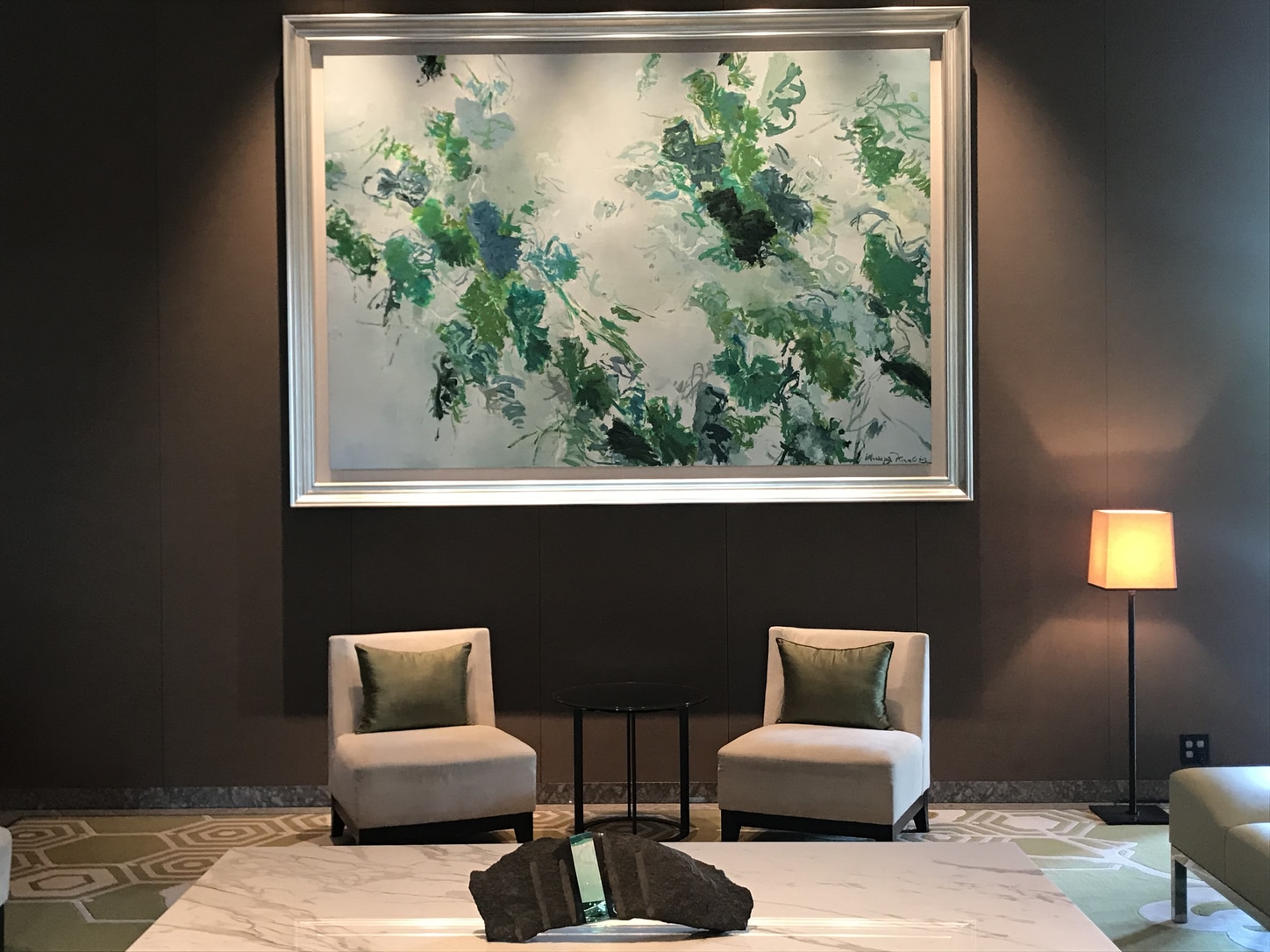
Abstract painting by Huang Yuan Qing
From the lobby and main reception area, some impressive highlights are Masahito Katayama’s bright yellow sunflowers, Himaku/Sunflower—2012, Mika Toba’s katazome stencil dyed Early Morning and Untitled — a pair of glowing green and red-orange abstract nature paintings by Huang Yuan Qing. As you ascend to the upper floors, charming woven balls hang from the ceiling.
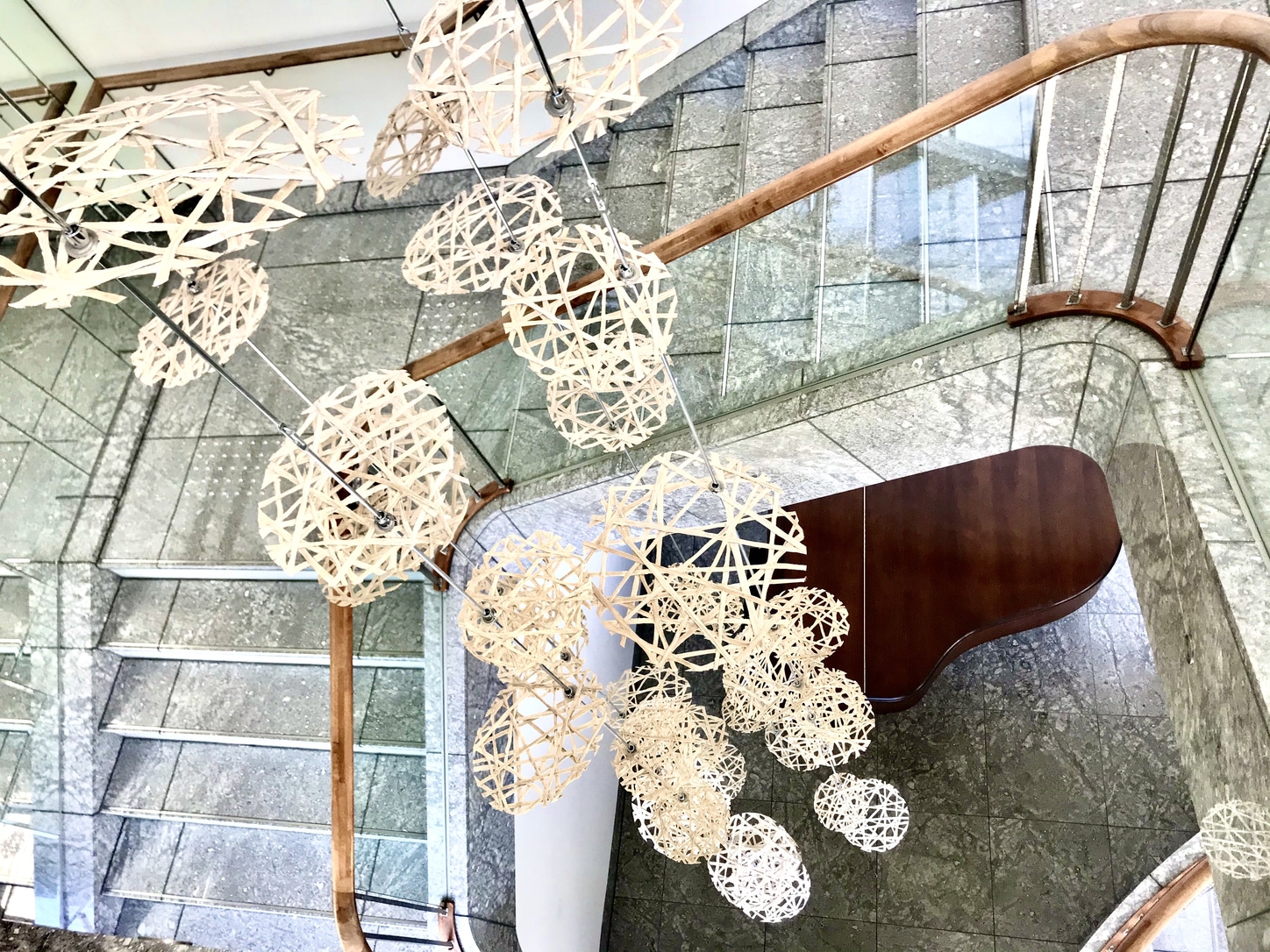
One of the most striking pieces is an oil painting of vibrant blue petals, Shikisai no Shita by Satoshi Uchiumi on the second floor. In the meeting rooms of the fourth floor, Fumie Hiratai’s serene sky vision, Amatsukaze and Aki Yamamoto’s Chirality, a multi-layered expression of nature’s reflection on the moat surrounding the nearby Imperial Palace, are utterly engaging. The spectacular views of the palace grounds against Tokyo’s skyline blend perfectly with the hotel’s sophisticated art, truly embodying the richness of Japanese culture.
4. Grand Hyatt Tokyo
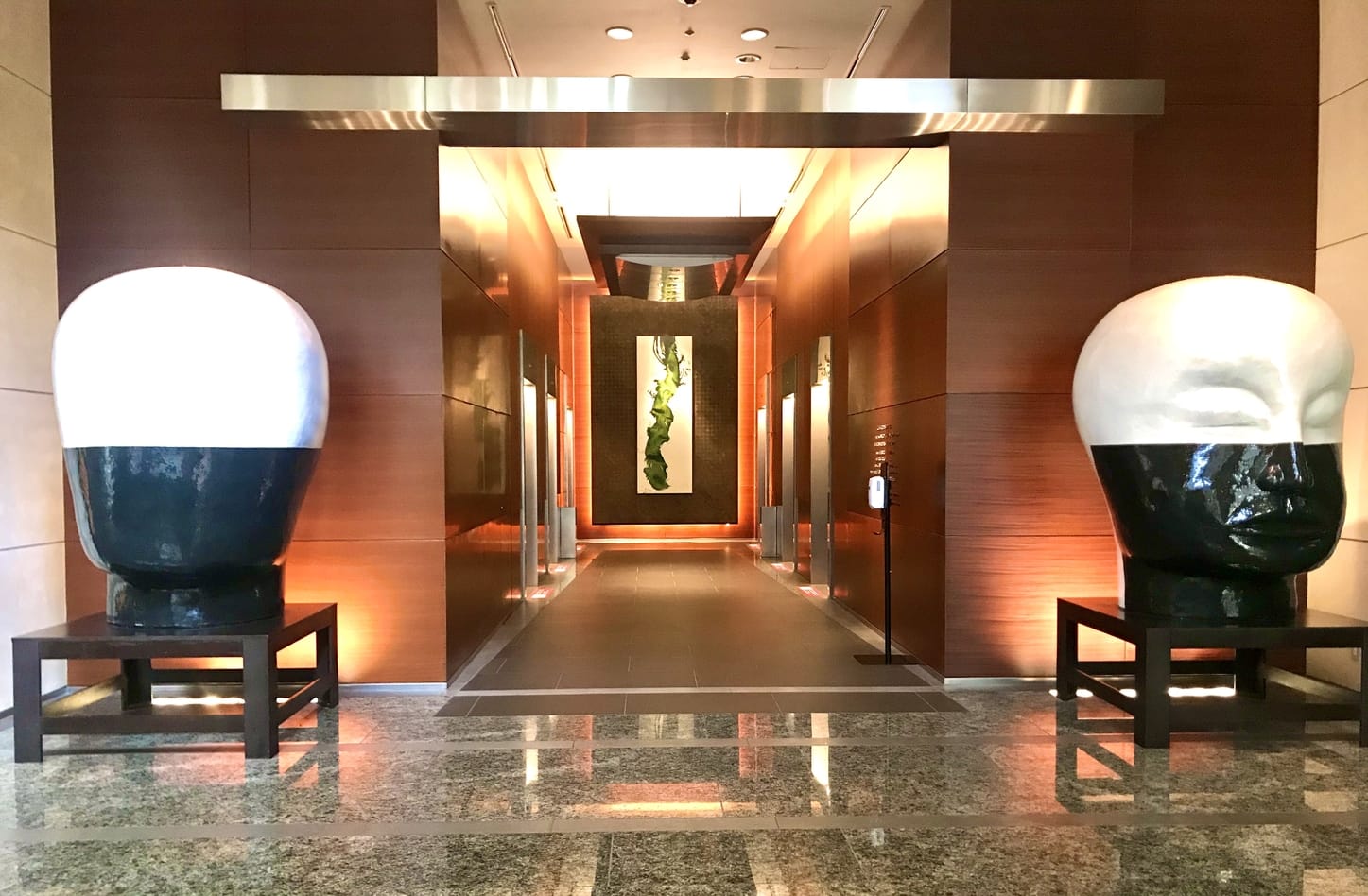
“Untitled Heads” by Jun Kaneko
Sitting right within the high-end commercial complex Roppongi Hills, the Grand Hyatt Tokyo is a state-of-the-art masterpiece of contemporary and minimalistic design. There are approximately 200 contemporary art pieces on the premises, mixing eastern and western styles. On the ground floor facing the main elevators, you can spot Jun Kaneko’s Untitled Heads, two gigantic ceramic sculptures.
At the end of the elevators is Expectation, an imposing abstract painting of green heavy brush strokes by British artist James Cares. There are also large fruit sculptures on other floors, such as apples and the Pear by Chinese artist Robert Kuo. Walking up the labyrinth of multi-leveled staircases, you can view the library lounge on the upper foyer with hanging sculptured hats and jackets on two walls, titled The Gallery by Naoyoshi Taniyama. Perhaps the most capturing artwork is Hiroshi Senju’s extraordinary abstract expression of flowing white waterfalls against black walls, the Waterfall. Adjacent to it is the absolutely radiant and modern wooden Shinto shrine with hoop pinewood floors and Bishu Hinoki wood walls.
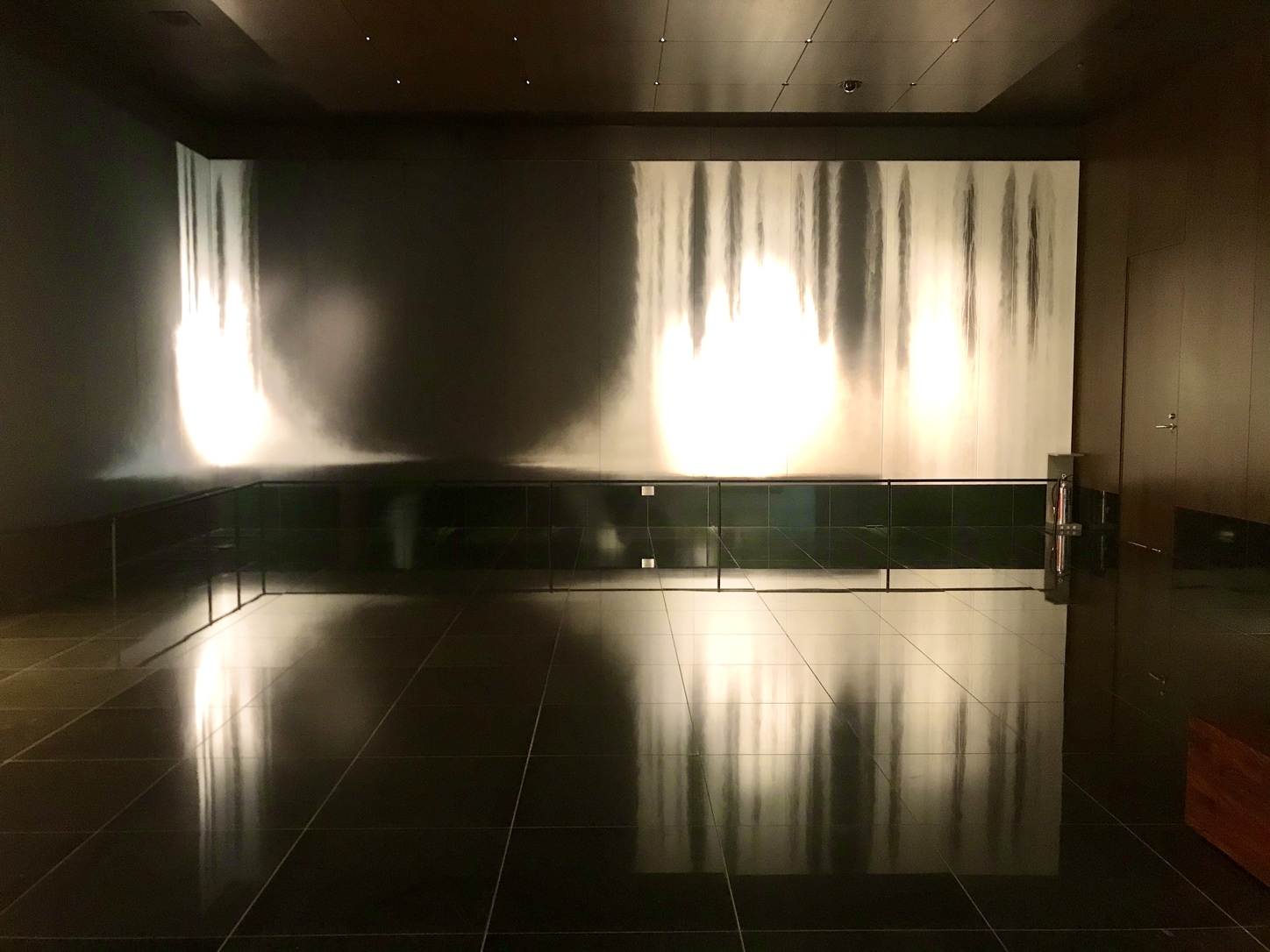
“Waterfall” by Hiroshi Senju
The Grand Hyatt often has art-related events. TW visited their luxurious Takashi Murakami art suite and shot a video there. At the time of writing, they have the “Hyatt Loves Local” initiative, a global effort by Hyatt hotels to support and collaborate with small businesses and local communities that have been impacted by the Covid-19 pandemic. Through the work of artists that continue to focus on their creations during the pandemic, the lobby of Grand Hyatt Tokyo is transformed into an art exhibit.
Diving Deeper in Art
Aside from these four key players, there are other interesting “art hotels” to explore around Tokyo. The newly opened BnA Wall in Nihonbashi, for instance, features 26 artistic guest rooms. They display a range of styles including minimalism, pop art, psychedelia and art deco. The rooms have been designed by a cohort of Tokyo-based artists. Then there’s Park Hotel Tokyo in Shiodome, the stylish Nohga Hotel in Ueno and the Kengo Kuma designed Capitol Hotel Tokyu in Nagatacho.
Similarly, luxury fashion brands often host free art exhibitions. Check our round-up of Tokyo Luxury Brand Boutiques: Free Art Galleries for more ideas.
Read more about art:
- Inside Grand Hyatt Tokyo’s ¥569,250 Takashi Murakami Suite
- Yayoi Kusama, Onsen and Stargazing in Towada City, Aomori Prefecture
- Watch This Space: Ichihara City in Chiba Prefecture is Where Contemporary Art and Daily Life Mix
All photos by Alma Reyes
Updated On June 28, 2021

